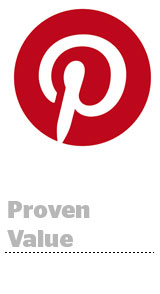 Here’s today’s AdExchanger.com news round-up… Want it by email? Sign-up here.
Here’s today’s AdExchanger.com news round-up… Want it by email? Sign-up here.
Up Pin The Cloud
Pinterest is proving its offline worth. The platform tapped Oracle Data Cloud to help it demonstrate the impact of promoted pins on offline sales. The duo also released a CPG-centric study that leveraged Oracle’s Datalogix tech to show how campaigns performed with households that use Pinterest vs. those that don’t. The result: Promoted pins drove five times more incremental store sales per impression than other campaigns measured by Oracle Data Cloud. It’s a shot in the arm for Pinterest, which has historically been a little challenged on the ad front. More in Ad Age.
Lights Out
Facebook pioneered in-feed native and autoplay video ads, which became standards across social media in general, and now it’s done the same with “Dark Posts,” a feature brands or accounts use to post content only to some users, or to keep posts off the public account page. Dark Posts mean brands or publishers don’t have to blast all their followers with content only some might like, and “are also useful when A/B testing different content strategies, because a brand can send up trial balloons without officially posting to its page,” writes Garett Sloane of Digiday. More.
The Homefront
Amid all the excitement over “the next billion” coming online in China and India, and what looks like a saturated American market for smartphones and internet growth, it’s easy to overlook the millions of Americans left behind by the digital revolution. For the government, this looks more and more like guaranteeing a fundamental right, while for businesses it’s both a challenge and an opportunity. “Ten percent of Americans, or 34 million people, lack access to what we define as high-speed internet,” FCC Commissioner Mignon Clyburn tells The New York Times in a Q&A. Whether it’s due to broadband cost or low digital literacy, there’s a significant pool of Americans who haven’t been siphoned into the digital economy.
World’s Worst Roller Coaster
Unnamed sources tell The Wall Street Journal that Verizon is expected to bid $3 billion for Yahoo’s web assets (so not including its real estate or patents). “The telecom giant likely would combine Yahoo’s web properties, which together attract more than a billion users a month, with its growing business in online ads.” Yahoo has a $35 billion market cap, but most of that comes from its stakes in Alibaba and Yahoo Japan, which the company has been struggling to spin off. More.
CPM No Go?
Native ad platform Polar predicts a future where publishers kick CPM-based pricing to the curb – at least where branded content is concerned. Although 57% of publishers still price branded content on CPMs, the company’s survey of 30 publishers found 48% claim they’re pricing based on cost per view. Such a shift, unsurprisingly, bodes well for Polar, which noted a “holdover” on CPMs from “media agencies that are [still] more comfortable with legacy digital advertising … [and] budgets usually tied to impressions and reach.” Blog post.
But Wait, There’s More!
- Google Is Bringing New Ad Types To AMP – TechCrunch
- How The Sanders Campaign Uses Ads To Grab Live Audiences – Adweek
- Petsky Prunier May 2016 Summary Of M&A Activity – release
- Report Shows Decline In Brand Desire To ‘In-House’ Tech – The Drum
- Survey Indicates SMBs Have Embraced Omnichannel – release
- Aarki Announces New Mobile Game App Ad Solution – release
- Samsung Is Working On Rollable, Foldable Device Screens – VentureBeat
- Teads Rolls Out Outstream Video Certification – release
- Native Ad Distribution Has A Transparency Problem – Digiday
You’re Hired
- Diply Hires Dan Lagani As President And CRO – release
- Hearst Digital Announces Senior Exec Hires – release
- Twitter Replaces Its Head Of Product. Again. – Recode
- Content.ad Appoints New CRO, CTO – release













